night vision CHEVROLET ASTRO PASSENGER 1993 1.G Owners Manual
[x] Cancel search | Manufacturer: CHEVROLET, Model Year: 1993, Model line: ASTRO PASSENGER, Model: CHEVROLET ASTRO PASSENGER 1993 1.GPages: 345, PDF Size: 19 MB
Page 177 of 345
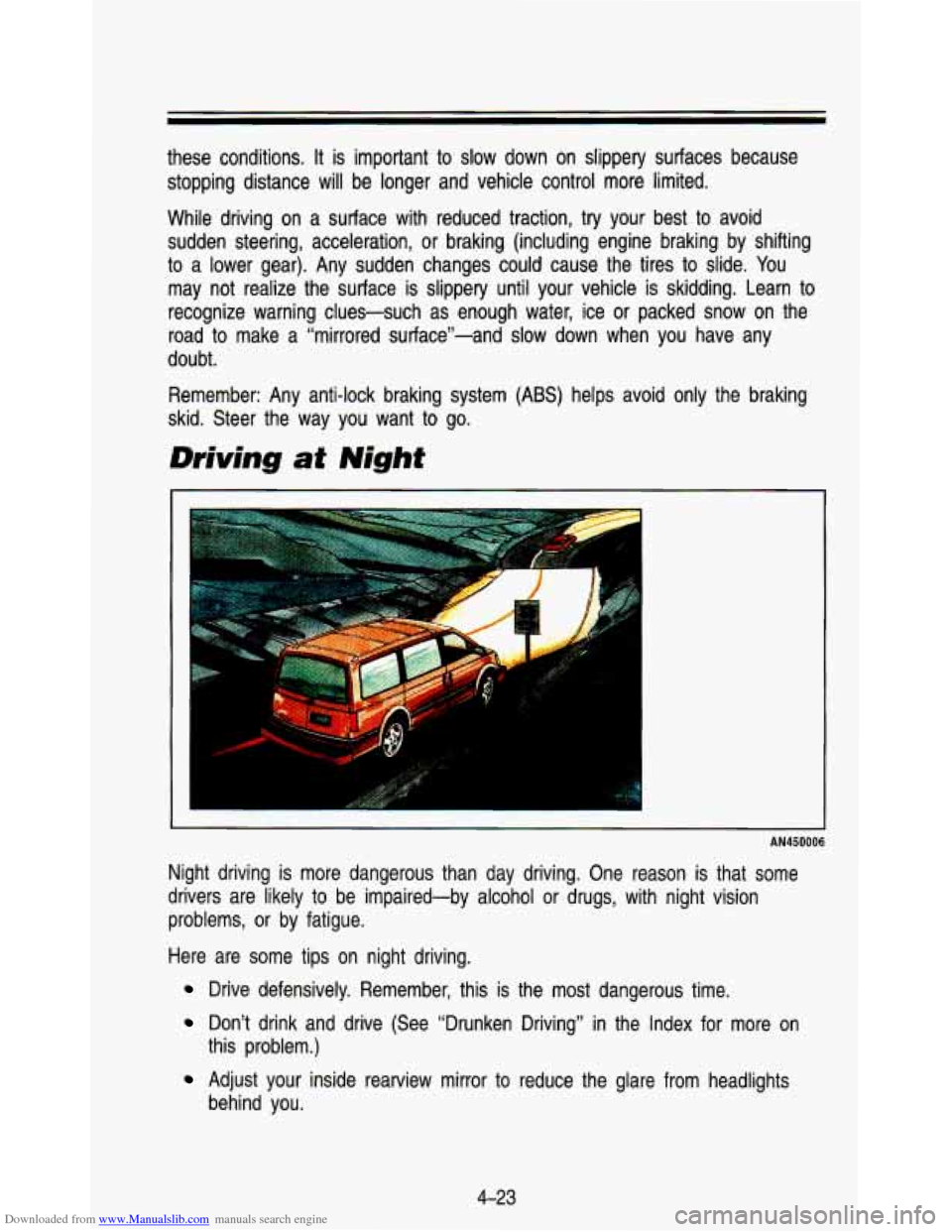
Downloaded from www.Manualslib.com manuals search engine these conditions. It is important to slow down on slippery surfaces because
stopping distance will be longer and vehicle control more limited.
While driving on a surface with reduced traction, try your best to avoid
sudden steering, acceleration, or braking (including engine brak\
ing by shifting
to a lower gear). Any sudden changes could cause the tires to s\
lide. You
may not realize the surface is slippery until your vehicle is skidding. Learn to
recognize warning clues-such as enough water, ice or packed sno\
w on the
road to make a “mirrored sutface”-and slow down when you have any\
doubt.
Remember: Any anti-lock braking system
(ABS) helps avoid only the braking
skid. Steer the way you want to go.
Driving at Night
AN450006
Night driving is more dangerous than day driving. One reason is that some
drivers are likely to be impaired-by alcohol or drugs, with night vision
problems, or by fatigue.
Here are some tips on night driving.
Drive defensively. Remember, this is the most dangerous time.
Don’t drink and drive (See “Drunken Driving” in the Index for more on
Adjust your inside rearview mirror to reduce the glare from he\
adlights
this problem.)
behind you.
4-23
Page 178 of 345
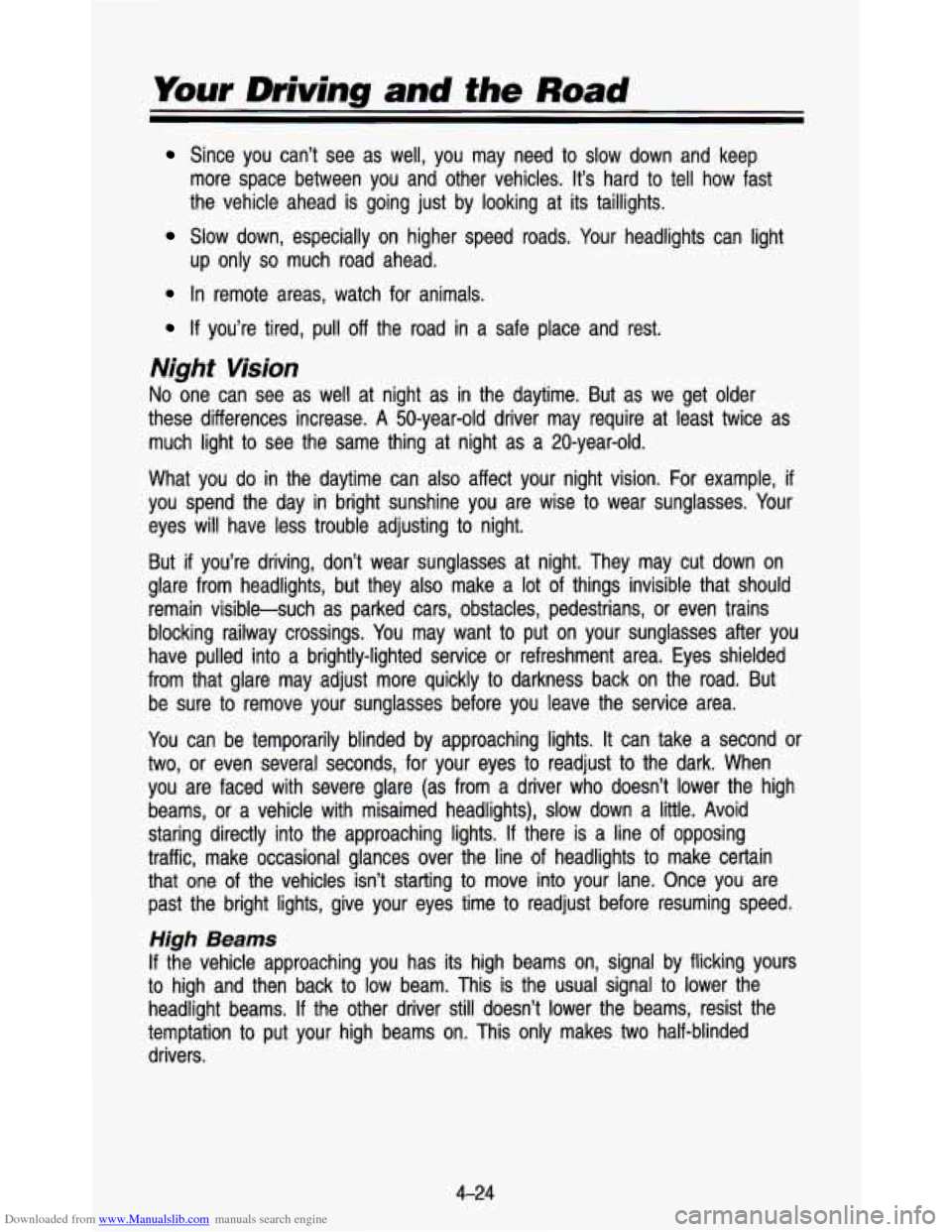
Downloaded from www.Manualslib.com manuals search engine Your Driving and the Road
Since you can’t see as well, you may need to slow down an\
d keep more space between you and other vehicles. It’s hard to tel\
l how fast
the vehicle ahead is going just by looking at its taillights. \
Slow down, especially on higher speed roads. Your headlights can light
up only
so much road ahead.
In remote areas, watch for animals.
If you’re tired, pull off the road in a safe place and rest.
Night Vision
No one can see as well at night as in the daytime. But as we \
get older
these differences increase.
A 50-year-old driver may require at least twice as
much light to see the same thing at night as a 20-year-old.
What you
do in the daytime can also affect your night vision. For example, if
you spend the day in bright sunshine you are wise to wear su\
nglasses. Your
eyes will have less trouble adjusting to night.
But
if you’re driving, don’t wear sunglasses at night. They may \
cut down on
glare from headlights, but they also make a lot of things inv\
isible that should remain visible-such as parked cars, obstacles, pedestrians,
or even trains
blocking railway crossings. You may want to put on your sunglasses after you
have pulled into a brightly-lighted service
or refreshment area. Eyes shielded
from that glare may adjust more quickly to darkness back on t\
he road. But be sure to remove your sunglasses before you leave the service area.
You can be temporarily blinded by approaching lights. It can take a second
or
two, or even several seconds, for your eyes to readjust to the dark. When
you are faced with severe glare (as from a driver who doesn’\
t lower the high beams,
or a vehicle with misaimed headlights), slow down a little. Avoid\
staring directly into the approaching lights.
If there is a line of opposing
traffic, make occasional glances over the line
of headlights to make certain
that one of the vehicles isn’t starting to move into your \
lane. Once you are past the bright lights, give your eyes time to readjust before resuming speed.
High Beams
If the vehicle approaching you has its high beams on, signal by \
flicking yours
to high and then back to low beam. This is the usual signal \
to lower the
headlight beams.
If the other driver still doesn’t lower the beams, resist the
temptation to put your high beams on. This only makes
two half-blinded
drivers.
4-24
Page 179 of 345
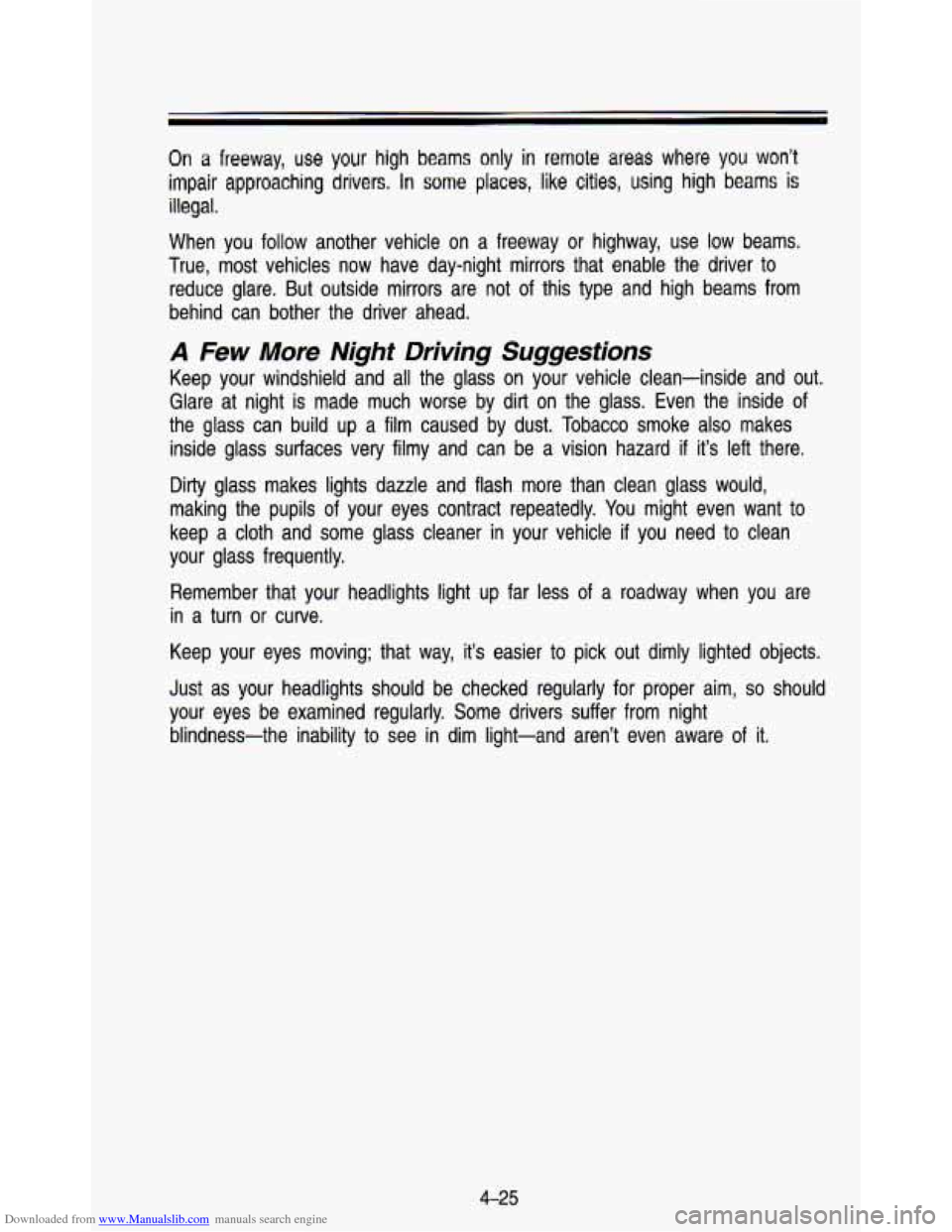
Downloaded from www.Manualslib.com manuals search engine On a freeway, use your high beams only in remote areas where you won’t
impair approaching drivers, In some places, like cities, using high beams is
illegal.
When you follow another vehicle on a freeway or highway, use
low beams.
True, most vehicles now have day-night mirrors that enable the \
driver to reduce glare. But outside mirrors are not of this type and hi\
gh beams from
behind can bother the driver ahead.
A Few More Night Driving Suggestions
Keep your windshield and all the glass on your vehicle clean-i\
nside and out.
Glare at night is made much worse by dirt on the glass. Even the inside
of
the glass can build up a film caused by dust. Tobacco smoke also makes
inside glass surfaces very filmy and can be a vision hazard
if it’s left there.
Dirty glass makes lights dazzle and flash more than clean glas\
s would,
making the pupils
of your eyes contract repeatedly. You might even want to
keep a cloth and some glass cleaner in your vehicle if you need to clean
your glass frequently.
Remember that your headlights light up far less of a roadway when you are
in a turn or curve.
Keep your eyes moving; that way, it’s easier to pick out dimly lighted objects.
Just as your headlights should be checked regularly for proper \
aim,
so should
your eyes be examined regularly. Some drivers suffer from night\
blindness-the inability to see in dim light-and aren’t even aware of it.
4-25
Page 188 of 345
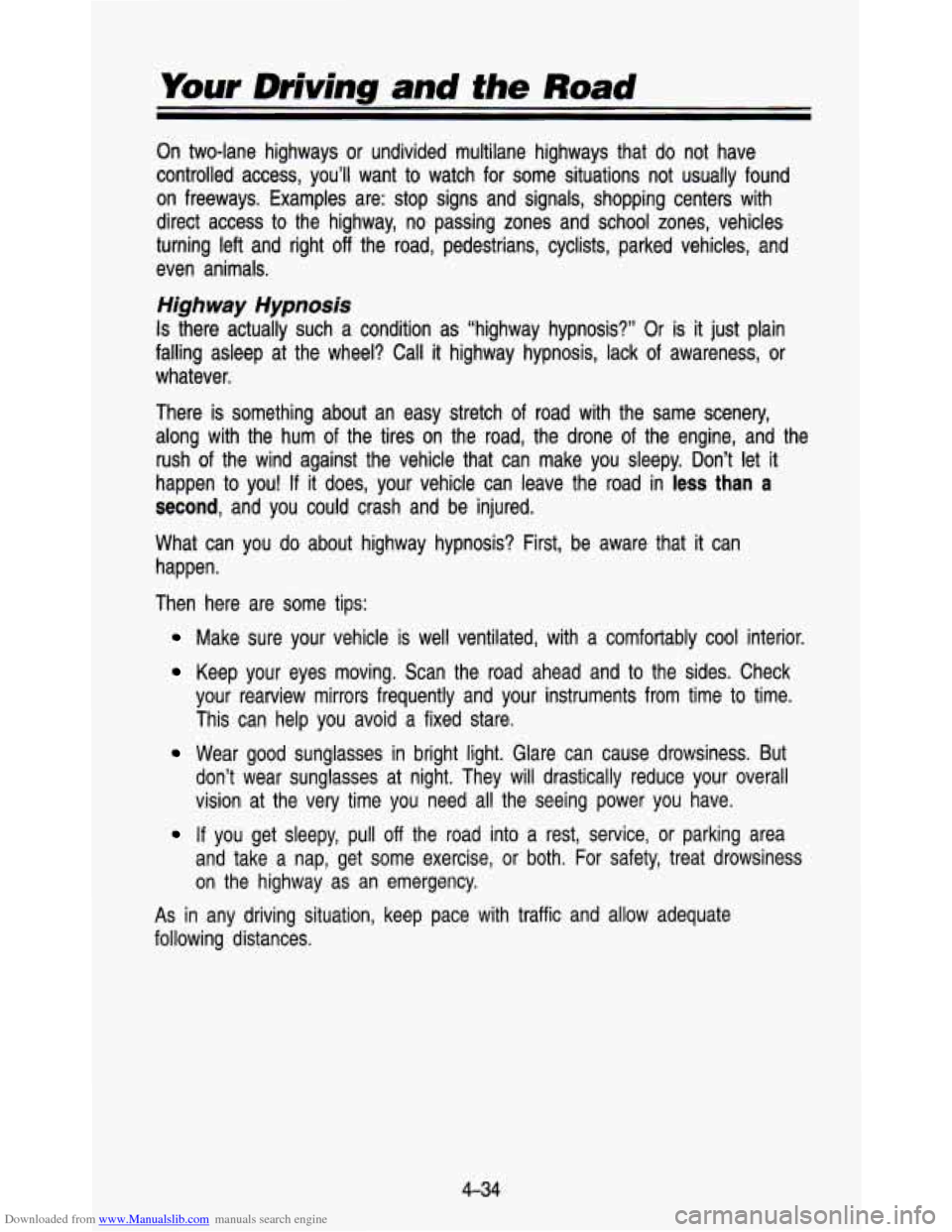
Downloaded from www.Manualslib.com manuals search engine Your Driving and the Road
On two-lane highways or undivided multilane highways that do not have
controlled access, you’ll want to watch for some situations not usually found
on freeways. Examples are: stop signs and signals, shopping cen\
ters with
direct access to the highway, no passing zones and school zones, vehicles
turning left and right
off the road, pedestrians, cyclists, parked vehicles, and
even animals.
Highway Hypnosis
Is there actually such a condition as “highway hypnosis?’’ Or is it just plain
falling asleep at the wheel? Call it highway hypnosis, lack of awareness, or
whatever.
There is something about an easy stretch
of road with the same scenery,
along with the hum
of the tires on the road, the drone of the engine, and the
rush
of the wind against the vehicle that can make you sleepy. Don’t le\
t it
happen to you!
If it does, your vehicle can leave the road in less than a
second, and you could crash and be injured.
What can you do about highway hypnosis? First, be aware that it can
happen.
Then here are some tips:
Make sure your vehicle is well ventilated, with a comfortably cool interior.
Keep your eyes moving. Scan the road ahead and to the sides. Check
your rearview mirrors frequently and your instruments from time \
to time.
This can help you avoid a fixed stare.
Wear good sunglasses in bright light. Glare can cause drowsiness. But
don’t wear sunglasses at night. They will drastically reduce \
your overall
vision at the very time you need all the seeing power you have.
If you get sleepy, pull off the road into a rest, service, or parking area
and take a nap, get some exercise, or both. For safety, treat\
drowsiness
on the highway as an emergency.
As in any driving situation, keep pace with traffic and allow adequat\
e
following distances.
4-34
Page 338 of 345
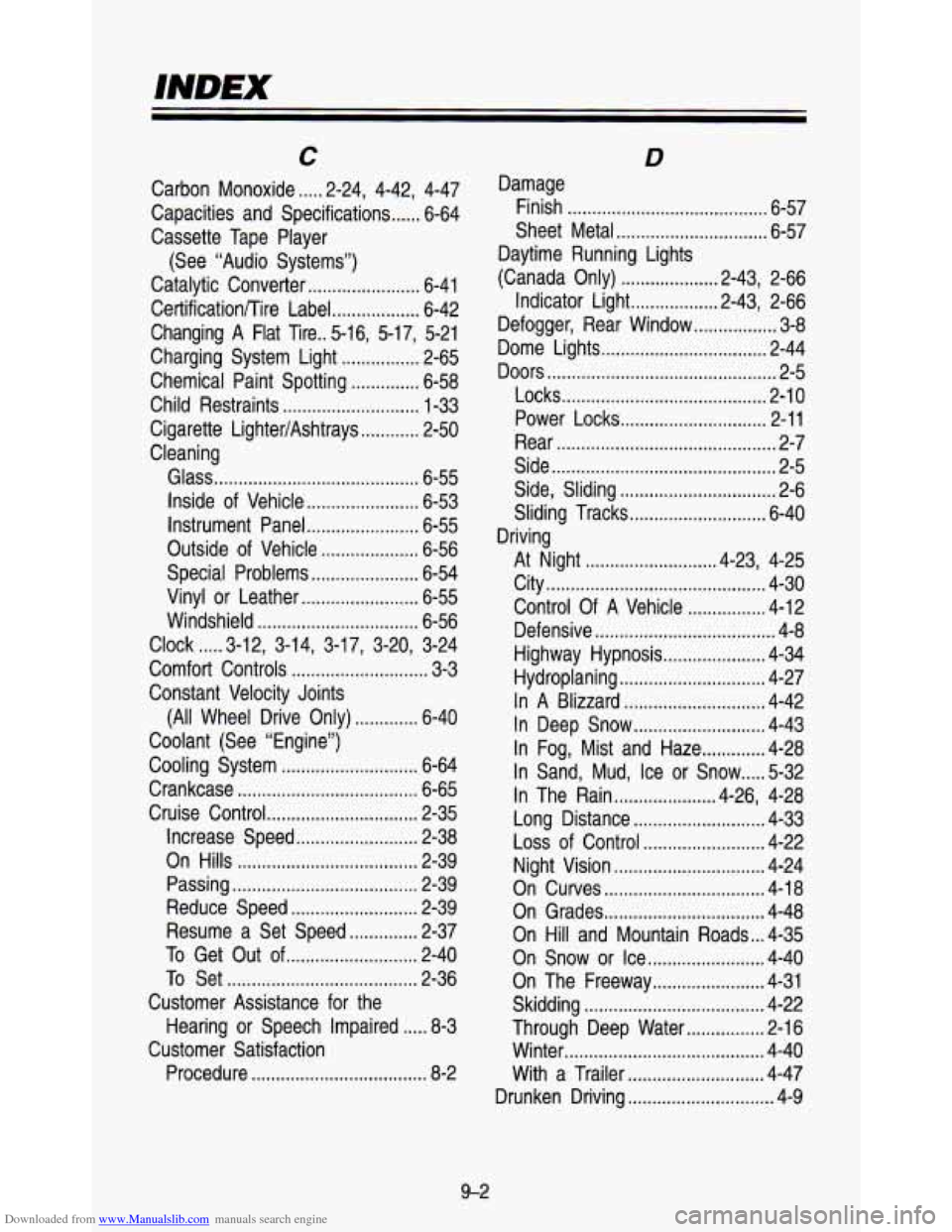
Downloaded from www.Manualslib.com manuals search engine c
Carbon Monoxide ..... 2.24. 4.42. 4-47
Capacities and Specifications
...... 6-64
Cassette Tape Player
Catalytic Converter
....................... 6-41
Certification/Tire Label
.................. 6-42
Changing
A Flat Tire .. 5.16. 5.17. 5-21
Charging System Light
................ 2-65
Chemical Paint Spotting
.............. 6-58
Child Restraints
............................ 1-33
Cigarette Lighter/Ashtrays
............ 2-50
Cleaning
Glass
.......................................... 6-55
Inside
of Vehicle ....................... 6-53
Instrument Panel
....................... 6-55
Outside of Vehicle .................... 6-56
Special Problems
...................... 6-54
Vinyl or Leather
........................ 6-55
Windshield
................................. 6-56
Comfort Controls
............................ 3-3
Constant Velocity Joints (All Wheel Drive Only)
............. 6-40
Coolant (See “Engine”)
Cooling System
............................ 6-64
Crankcase
..................................... 6-65
Cruise Control
............................... 2-35
Increase Speed
......................... 2-38
On Hills
..................................... 2-39
Passing
...................................... 2-39
Reduce Speed
.......................... 2-39
Resume a Set Speed
.............. 2-37
To Get Out of
........................... 2-40
To Set
....................................... 2-36
Hearing or Speech Impaired
..... 8-3
Procedure
.................................... 8-2
(See “Audio Systems”)
Clock
..... 3-12, 3-14. 3-17, 3-20, 3-24
Customer Assistance for the Customer Satisfaction
D
Finish ......................................... 6-57
Sheet Metal
............................... 6-57
Daytime Running Lights
(Canada Only)
.................... 2-43, 2-66
Indicator Light
.................. 2-43, 2-66
Defogger, Rear Window
................. 3-8
Dome Lights
.................................. 2-44
Doors
............................................... 2-5
Power Locks
.............................. 2-11
Rear
............................................. 2-7
Side
.............................................. 2-5
Side, Sliding
................................ 2-6
Sliding Tracks
............................ 6-40
At Night
........................... 4-23, 4-25
City
............................................. 4-30
Control
Of A Vehicle ................ 4-12
Defensive
..................................... 4-8
Highway Hypnosis
..................... 4-34
Hydroplaning
.............................. 4-27
In
A Blizzard ............................. 4-42
In Deep Snow
........................... 4-43
In Fog, Mist and Haze
............. 4-28
In Sand, Mud, Ice or Snow
..... 5-32
In The Rain
..................... 4-26, 4-28
Long Distance
........................... 4-33
Loss
of Control ......................... 4-22
Night Vision
............................... 4-24
On Curves
................................. 4-18
On Grades
................................. 4-48
On Hill and Mountain Roads
... 4-35
On Snow or Ice
........................ 4-40
On The Freeway
....................... 4-31
Skidding
..................................... 4-22
Through Deep Water
................ 2-16
Winter
......................................... 4-40
With a Trailer
............................ 4-47
Drunken Driving
.............................. 4-9
Damage
Locks
.......................................... 2-10
Driving
9-2